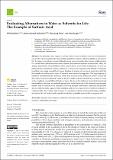Evaluating Alternatives to Water as Solvents for Life: The Example of Sulfuric Acid
Author(s)
Bains, William; Petkowski, Janusz Jurand; Zhan, Zhuchang; Seager, Sara
Downloadlife-11-00400-v2.pdf (5.947Mb)
Terms of use
Metadata
Show full item recordAbstract
The chemistry of life requires a solvent, which for life on Earth is water. Several alternative solvents have been suggested, but there is little quantitative analysis of their suitability as solvents for life. To support a novel (non-terrestrial) biochemistry, a solvent must be able to form a stable solution of a diverse set of small molecules and polymers, but must not dissolve all molecules. Here, we analyze the potential of concentrated sulfuric acid (CSA) as a solvent for biochemistry. As CSA is a highly effective solvent but a reactive substance, we focused our analysis on the stability of chemicals in sulfuric acid, using a model built from a database of kinetics of reaction of molecules with CSA. We consider the sulfuric acid clouds of Venus as a test case for this approach. The large majority of terrestrial biochemicals have half-lives of less than a second at any altitude in Venus’s clouds, but three sets of human-synthesized chemicals are more stable, with average half-lives of days to weeks at the conditions around 60 km altitude on Venus. We show that sufficient chemical structural and functional diversity may be available among those stable chemicals for life that uses concentrated sulfuric acid as a solvent to be plausible. However, analysis of meteoritic chemicals and possible abiotic synthetic paths suggests that postulated paths to the origin of life on Earth are unlikely to operate in CSA. We conclude that, contrary to expectation, sulfuric acid is an interesting candidate solvent for life, but further work is needed to identify a plausible route for life to originate in it.
Date issued
2021-04-27Department
Massachusetts Institute of Technology. Department of Earth, Atmospheric, and Planetary Sciences; Massachusetts Institute of Technology. Department of Physics; Massachusetts Institute of Technology. Department of Aeronautics and AstronauticsPublisher
Multidisciplinary Digital Publishing Institute
Citation
Life 11 (5): 400 (2021)
Version: Final published version